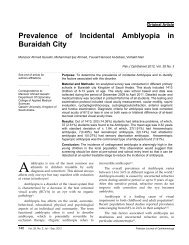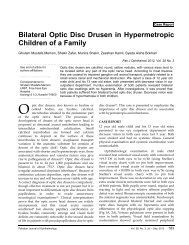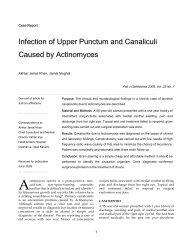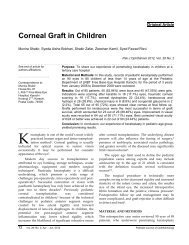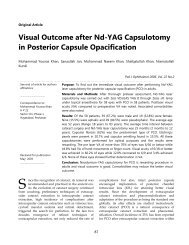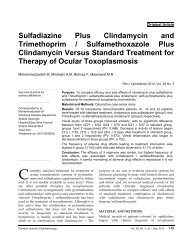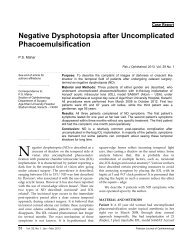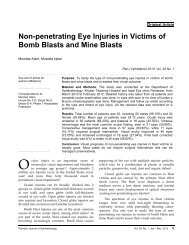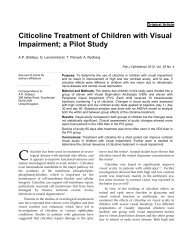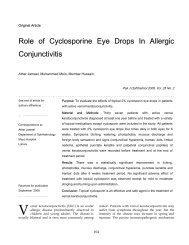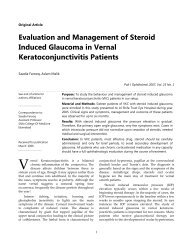Comparison Between Central Corneal Thickness Measurements ...
Comparison Between Central Corneal Thickness Measurements ...
Comparison Between Central Corneal Thickness Measurements ...
You also want an ePaper? Increase the reach of your titles
YUMPU automatically turns print PDFs into web optimized ePapers that Google loves.
placement on the corneal center 10 . Orbscan<br />
pachymetry measures corneal thickness like manual<br />
ultrasound pachymetry but it is more repeatable,<br />
simpler to perform, non-invasive and returns a map of<br />
corneal thickness rather than a point measurement. It<br />
combines a slit scanning system and a Placido disk<br />
(with 40 rings) to measure the anterior elevation and<br />
curvature of the cornea and the posterior elevation<br />
and curvature of cornea, it offers a full corneal<br />
pachymetry map with white to white measurements.<br />
Orbscan pachymetry is able to acquire over 9000 data<br />
points in 1.5 seconds and measure anterior chamber<br />
depth, angle kappa, pupil diameter, simulated<br />
keratometry readings and the thinnest corneal<br />
pachymetry reading 11 .<br />
In this study, we compared central corneal<br />
thickness measurements in prekeratorefractive surgery<br />
eyes such as Laser in-situ keratomileusis (LASIK),<br />
Laser sub-epithelial keratomileusis (LASEK) and<br />
Photorefractive keratectomy (PRK) obtained with<br />
Orbscan II scanning slit topographer (Bausch and<br />
Lomb, Rochester, NY, USA) and ultrasonic<br />
pachymetry (Pocket II Pachymeter Echo graph,<br />
Quantel Medical Inc. USA).<br />
The purpose of this study was, to compare the<br />
central corneal thickness measurements obtained with<br />
Orbscan II scanning slit topographer and ultrasonic<br />
pachymeter in eyes undergoing corneal refractive<br />
surgery.<br />
MATERIAL AND METHODS<br />
The proposed study was a non-interventional study<br />
spanning over a period of 12 months from January<br />
2005 to December 2005, conducted at Hashmanis eye<br />
hospital, Karachi. The object of this study was, to<br />
compare the central corneal thickness values from<br />
Orbscan II topographer and ultrasonic pachymeter.<br />
In this study central corneal thickness was<br />
evaluated in 108 eyes (54 right eyes, 54 left eyes) of 54<br />
subjects (21 males and 33 females) who had undergone<br />
corneal refractive surgeries (LASIK, LASEK, PRK).<br />
Data was analyzed by SPSS software and we applied<br />
paired t-test for P value.<br />
The average age of patients was 29.85 years. There<br />
was no upper age limit in this study. Patients below<br />
the age of 18 years were not included in this study.<br />
Patients with clinically significant ocular<br />
pathologic conditions (e.g. keratoconus), dry eyes,<br />
underlying autoimmune vasculopathies (e.g. lupus,<br />
rheumatoid arthritis, polyarteritis nodosa etc.),<br />
systemic diseases known to effect corneal healing,<br />
functionally monocular vision, taking medication<br />
affecting wound healing such as steroids, unable to<br />
discontinue rigid contact lenses for a minimum of 4<br />
weeks or soft contact lenses for 1 week before<br />
procedure were excluded from the study.<br />
Informed consent was obtained form all patients.<br />
All eyes were examined with scanning slit<br />
topographer and ultrasonic pachymeter.<br />
For Orbscan measurements, the patient’s chin was<br />
placed on the chin rest and the forehead was pressed<br />
against the forehead strap. The patient was asked to<br />
look at a blinking red fixation light. The examiner<br />
adjusted the optical head using a joystick to align and<br />
focus the eye so that the cornea was centered on the<br />
video monitor. The video image was then captured<br />
and measured anterior and posterior corneal elevation<br />
(relative to a best fit sphere), surface curvature and<br />
corneal thickness. Pachymetry is determined by this<br />
instrument from the difference in elevation between<br />
the anterior and posterior surface of the cornea. This<br />
instrument averages pachymetry in nine circles of<br />
2mm diameter that are located in the center of the<br />
cornea and at eight locations in the mid peripheral<br />
cornea (superior, superotemporal, temporal,<br />
inferotemporal, inferior, inferonasal, nasal,<br />
superonasal) each located 3mm form the visual axis.<br />
The Orbscan corneal topography system also<br />
determines the thinnest point on cornea and marks its<br />
distance from visual axis and its quadrant location<br />
(superotemporal, inferotemporal, superonasal and<br />
inferonasal).<br />
For ultrasonic pachymetry, measurements were<br />
taken on the table before surgery. The cornea was<br />
anaesthetised with topical proparacaine hydrochloride<br />
0.5% (Alcain) and asked the patient to look at distant<br />
object. The sterilized probe was applied as<br />
perpendicular as possible on the central cornea and<br />
three consecutive measurements were made with<br />
Pocket II. The Pocket II uses the principle of sonar<br />
(pulsed ultrasound) to measure corneal thickness. The<br />
Ultrasonic transducer makes contact with and<br />
transmits ultrasonic pulses through the surface of the<br />
cornea. Echoes are returned from the anterior and<br />
posterior surfaces of the cornea. The system measures<br />
the time between returning echoes and using the<br />
known values of the velocity of sound in the corneas<br />
and calculates the thickness.<br />
88



